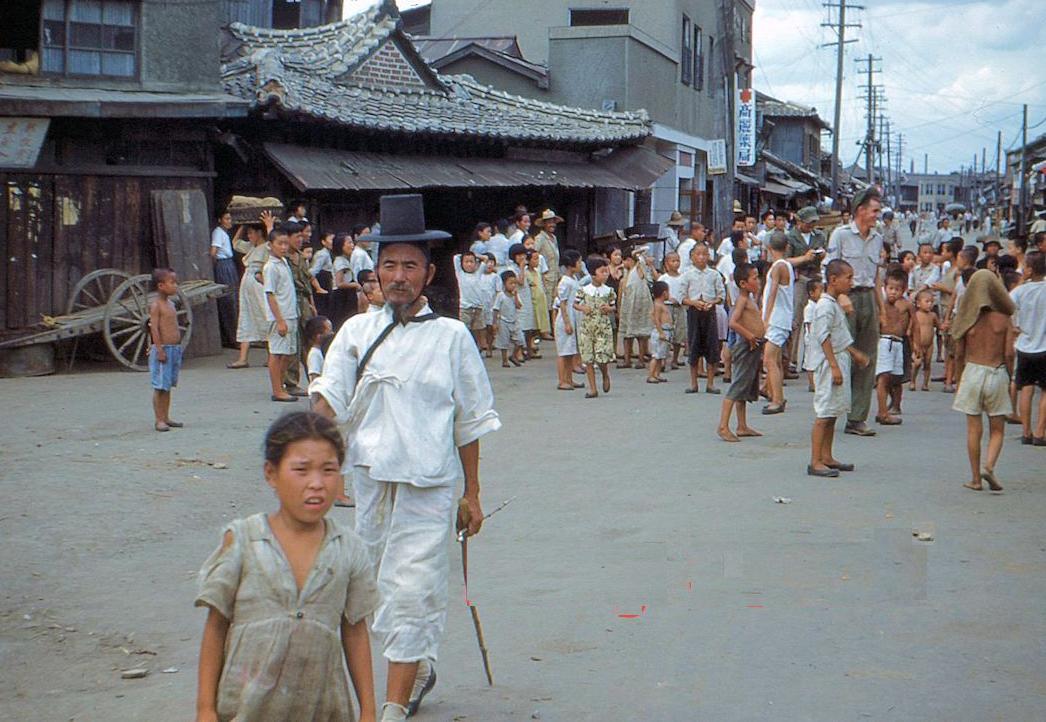
South Korean Economy: Initial Economic Policies (1945-60)

Figure 1.--Here we see a Korean street scene in 1952. The Korean War was still going on, but the front had been stabilized more are lass at the 38th paralell. Notice that there is not one car or truck anywhere in sight. The ROK Goverment;s initial economic policies were similar to those being implemented throughout the Third World and they failed, just as they dailed inother countries during the de-colonization process. The one advantage South Korea had was substantial America economic assistance. While important as in other countries, the aid proved less importabt than the policies adopted. And the policies the ROK Government initially adopted proved a failure.
|
|
Korea as it turned out would be on of the firstvcounries to be involved in the de-colonization process. The Americn Military Government coinfiscated Japabese properies and privarized in among South Koeans. The Reoublic of Korean Goverment when formed conducted aand reform program. Large estates were broken up and turned iver to peasant farmers. Much of the limited modern infrastructure which existed in the south was destroyed in the Korean War. Little changed immediately after the War. South Korea survived on American foreign aid. The country was largely ruled by the Army. The population lived in poverty, not unlike much of Asia. Large numbers of unemployed people struggled in a mostly agricultural economy using primitive methods. The economy offered little opportunity. The country was short of everything, including food in an agricultural area. The only resource the South had was a relatively well educated people, in part thanks to the Japanese. The United States paid little attention to Korea before the Korean War. Beginning with the War the United States began a major aid program. The military presence of the United states and other counries by itself provide an economic stimulus. With the end of the Korean War, ROK officials set about rebuilding a destroyed economy. They pursued similar policies adopted by other new countties in the de-colonization process in Asia and Africa. ROK economic managers attemnpted to stimulatie economic growth by promoting indigenous industrial firms. The Government selected companies in industries considered important. They were given preferential treatment. such as access to foreign currencies and and credit at preferential rates. The Government erected high tariff barriers to protect domestic industries. Imports of manufactured goods was virtually imported. The theory was that the protection would give domestic manufactures the ability to become modern, efficent producers. The economic policy was known as import-substitution industrialization (ISI). In practice, however, rather than develop into competive corporations, Korean entrepreneurs, like businessmen in other developing countries attempting this policy in reality tended to be more concerned in maximizing Government support than the more difficult task of building a modern competive manufacturing concern. The commonly obtained favors by bribing Governmen bureaucrats and politicians. This same outcome was occuring throughout the many new states created by de-colonization. Economists created a new term for what occurred -- directly unproductive profit-seeking activities (DUP). The result rather than creating conditions for the development of a modern manufacturing industry, the efficiency of existing manufacturing actually declined. Living standards stagnated at very low levels. This was part of the reason that the Firt Republic collapsed (April 1960).
Sources
Cha, Myung Soo. Yeungnam University. "The economic history of Korea," EH.net, undated, retrieved August 22, 2014.
CIH

Navigate the Children in History Web Site:
[Return to the Main South Korean economic page]
[Return to the Main Korean post-World War II page]
[Return to the Main Korean economics page]
[Return to the Main Asian country economics page]
[Return to the Main country economics page]
[Return to the Main Korean War page]
[Introduction]
[Biographies]
[Chronology]
[Climatology]
[Clothing]
[Disease and Health]
[Economics]
[Geography]
[History]
[Human Nature]
[Law]
[Nationalism]
[Presidents]
[Religion]
[Royalty]
[Science]
[Social Class]
[Bibliographies]
[Contributions]
[FAQs]
[Glossaries]
[Images]
[Links]
[Registration]
[Tools]
[Children in History Home]
Navigate the HBC National Pages:
[Return to the Main Korean page]
[Return to the Main Asian country page]
[Return to the Main countries page]
[Bangladesh]
[Burma]
[Cambodia]
[China]
[India]
[Japan]
[Laos]
[Mongolia]
[Russia]
[Taiwan]
[Thailand]
[Tibet]
[Vietnam]
Created: 2:38 AM 9/21/2017
Last updated: 2:38 AM 9/21/2017



